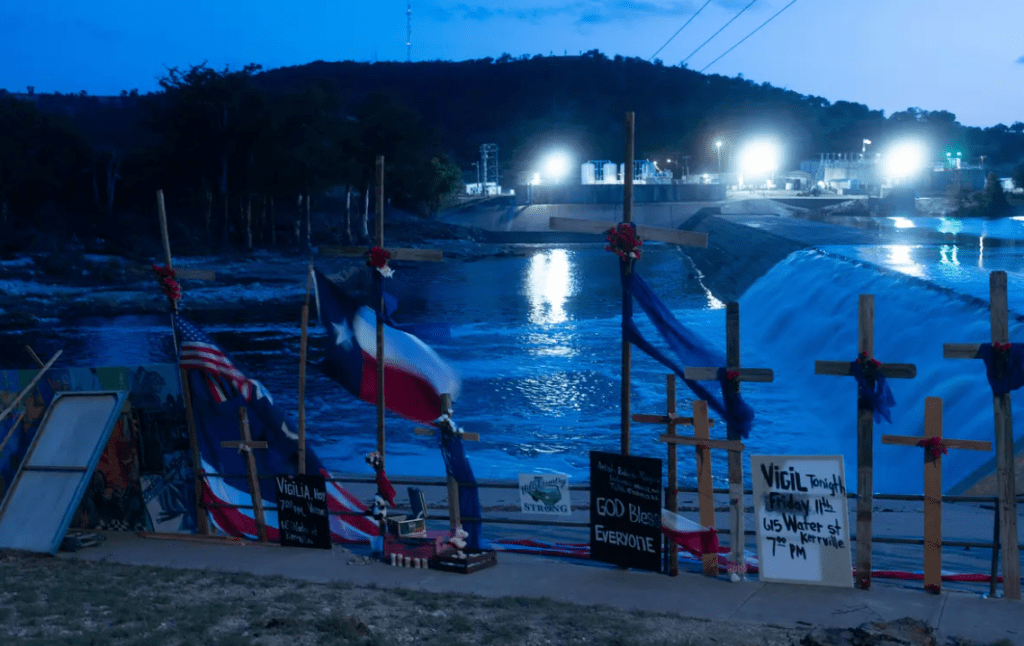New floods lead to rescues and evacuations across Texas
Published 6:23 am Monday, July 14, 2025

- Crosses honoring the victims of the Hill Country floods, seen on July 11, 2025, were erected by artist Roberto Marquez next to the Guadalupe River in Guadalupe Park. Search efforts were suspended Sunday amid new warnings of potential flash flooding in the region. Storms on Sunday brought more floods across Central and North Texas, leading to rescues and evacuations in several counties. (Brenda Bazán for The Texas Tribune)
A storm system brought a new round of dangerous flooding across North and Central Texas on Sunday, leading to rescues and evacuations in multiple counties and suspending search efforts for victims of catastrophic floods that killed at least 120 people in the Hill Country a week ago.
Gov. Greg Abbott said Sunday afternoon that the state was conducting rescues in San Saba, Lampasas and Schleicher counties, with evacuations taking place in Lampasas, Menard, Kimble and Sutton counties.
“We are expanding operations in all affected counties — all while monitoring the rising waters in Kerrville,” Abbott said in a post on X. Kerrville, in Kerr County, is where rescue and recovery operations have focused after the Fourth of July floods in the Hill Country.
Trending
Dozens of Texans had been rescued from the Lampasas area by mid-Sunday afternoon, Abbott said. One rescue was made in Schleicher County Sunday morning, according to the county Sheriff’s Office.
Some rescues have also been made in San Saba County, Emergency Management Coordinator Marsha Hardy said, as police and volunteers spread out this morning to alert residents of both mandatory and recommended evacuation orders.
Hardy said the evacuations have gone without issue, and she hopes the rest of the rain won’t cause any more major problems so they can shift to recovery efforts.
“It’s now a matter, once again, of everybody working their way back home, probably tomorrow, and seeing what kind of damage they might have received,” Hardy said.
Sunday afternoon, U.S. Rep. August Pfluger R-Texas, who represents San Saba, posted: “Please take this seriously as the river is rising faster than it did on July 4.”
Officials in Kendall and Menard counties told residents in some parts that evacuations are currently voluntary.
Trending
Emergency crews in Kerr County suspended their search for victims of last week’s flash floods on Sunday morning, resuming in the western parts of Kerr County by 3 p.m. The Ingram Fire Department ordered search crews to immediately evacuate the Guadalupe River corridor until further notice, warning the potential for flash floods was high.
Search and rescue efforts were expected to resume on Monday, depending on river flow, Fire Department spokesperson Brian Lochte said.
On a Facebook post, the department warned area residents to stay away from river beds and roads.
The National Oceanic and Atmospheric Administration reported “major” floods at the San Saba River at San Saba, which reached 27 feet by 1:30 p.m. Sunday, and at the Lampasas River at Kempner, which reached 33 feet. San Saba County Judge Jody Fauley issued a mandatory evacuation order for some parts of the county as the National Weather Service forecast the San Saba River would crest higher than 31 feet by midnight.
By 3:20 p.m. Sunday, floodwaters had begun to recede in Lampasas, said Julian Thorpe, a communications representative at the Lampasas Sheriff’s Office.
“We’ve made sure everyone has been evacuated from the areas that need to be evacuated. The only ongoing issue that I’m aware of is that the Kempner bridge is blocked off,” Thorpe said, adding that he didn’t have details about rescues in the area.
NOAA also reported “moderate” floods at the Leon River at Gatesville and Cowhouse Creek near Pidcoke in Coryell County and at the Llano River near Junction in Kimble County.
Sunday evening, the National Weather Service extended its flood watch for the region to 9 a.m. Monday, explaining that one to three inches of rain was possible overnight.
An alert from the weather service’s Austin-San Antonio office issued early Sunday warned that the Central Texas region is particularly susceptible to flooding as the soil remains “near to saturation or at saturation levels” from the July 4 storms.
That weekend, the destructive, fast-moving waters rose 26 feet on the Guadalupe River in just 45 minutes before daybreak on July 4, washing away homes and vehicles. Ever since, searchers have used helicopters, boats and drones to look for victims and to rescue people stranded in trees and from camps isolated by washed-out roads.
This summer, flash flooding driven by bursts of heavy rain turned deadly elsewhere in Texas. In San Antonio in June, more than 7 inches of rain fell over a span of hours, prompting dozens of rescues from the fast-rising floodwaters and killing at least 13.
With information from the Associated Press
This article originally appeared in The Texas Tribune, a member-supported, nonpartisan newsroom informing and engaging Texans on state politics and policy. Learn more at texastribune.org.






